Information System Analysis: OLA Ride-Sharing Services Report
VerifiedAdded on 2022/08/19
|8
|1605
|19
Report
AI Summary
This report provides an in-depth analysis of OLA's information system, examining its role in the ride-sharing and taxi industry. It begins with an introduction highlighting the growth of the information economy and its impact on the taxi industry. The report then outlines OLA's organizational background, including its services like ride-sharing, food delivery, and taxi services. A discussion section delves into OLA's operational strategies, marketing strategies, and its use of Facebook for brand promotion. It analyzes how OLA targets its audience and segments its market. The report concludes by summarizing the key findings and offering recommendations for future growth, such as leveraging information systems and social media platforms to expand its customer base. The report uses various sources to support its claims, including academic journals and industry reports. The report's structure includes an introduction, statement of topic, organizational background, discussion, conclusion, and recommendations, along with a list of references.

Running head: - INFORMATION SYSTEM IN OLA
INFORMATION SYSTEM IN OLA
Name of the Student
Name of the University
Author Note
INFORMATION SYSTEM IN OLA
Name of the Student
Name of the University
Author Note
Paraphrase This Document
Need a fresh take? Get an instant paraphrase of this document with our AI Paraphraser
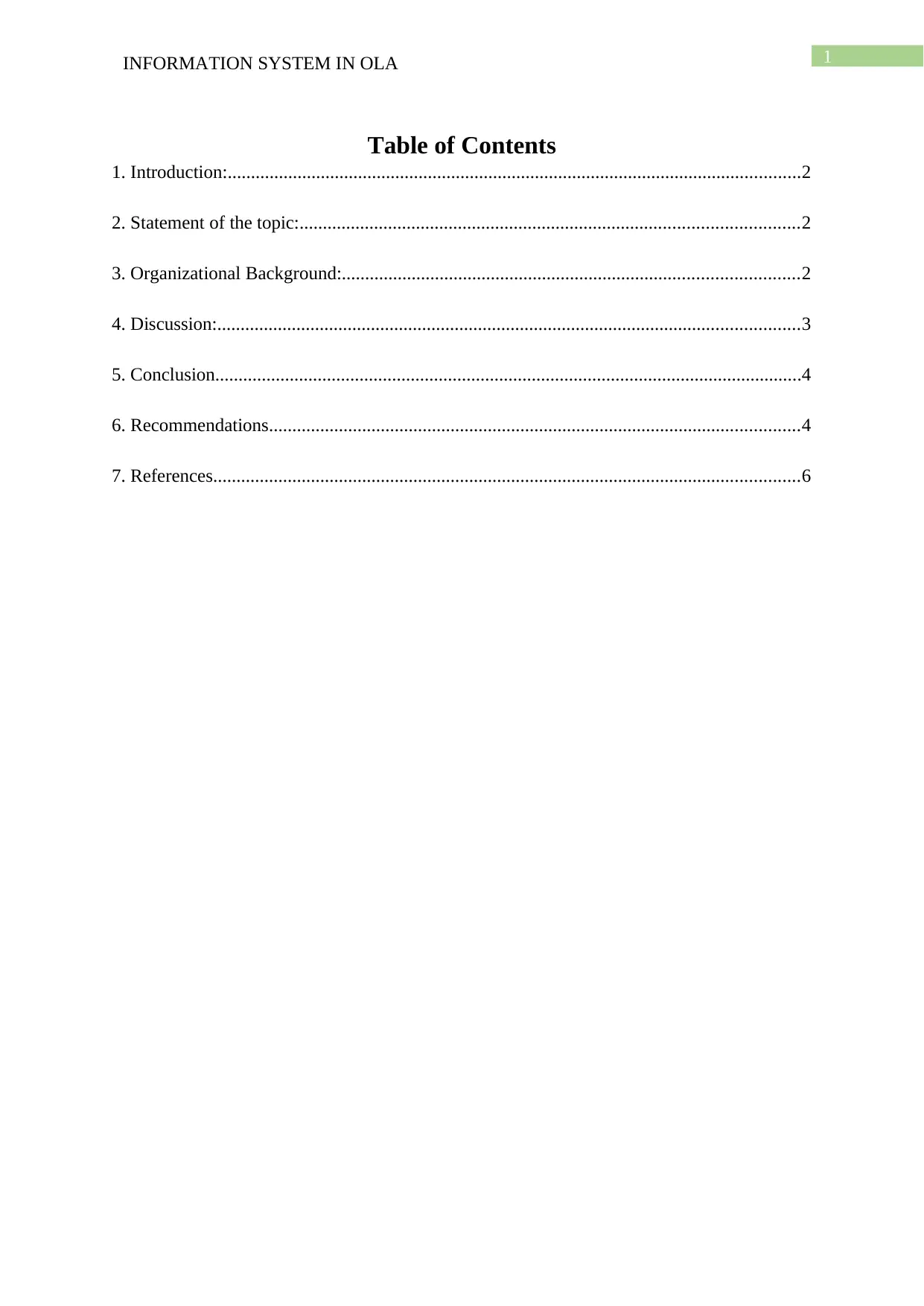
1INFORMATION SYSTEM IN OLA
Table of Contents
1. Introduction:...........................................................................................................................2
2. Statement of the topic:...........................................................................................................2
3. Organizational Background:..................................................................................................2
4. Discussion:.............................................................................................................................3
5. Conclusion..............................................................................................................................4
6. Recommendations..................................................................................................................4
7. References..............................................................................................................................6
Table of Contents
1. Introduction:...........................................................................................................................2
2. Statement of the topic:...........................................................................................................2
3. Organizational Background:..................................................................................................2
4. Discussion:.............................................................................................................................3
5. Conclusion..............................................................................................................................4
6. Recommendations..................................................................................................................4
7. References..............................................................................................................................6
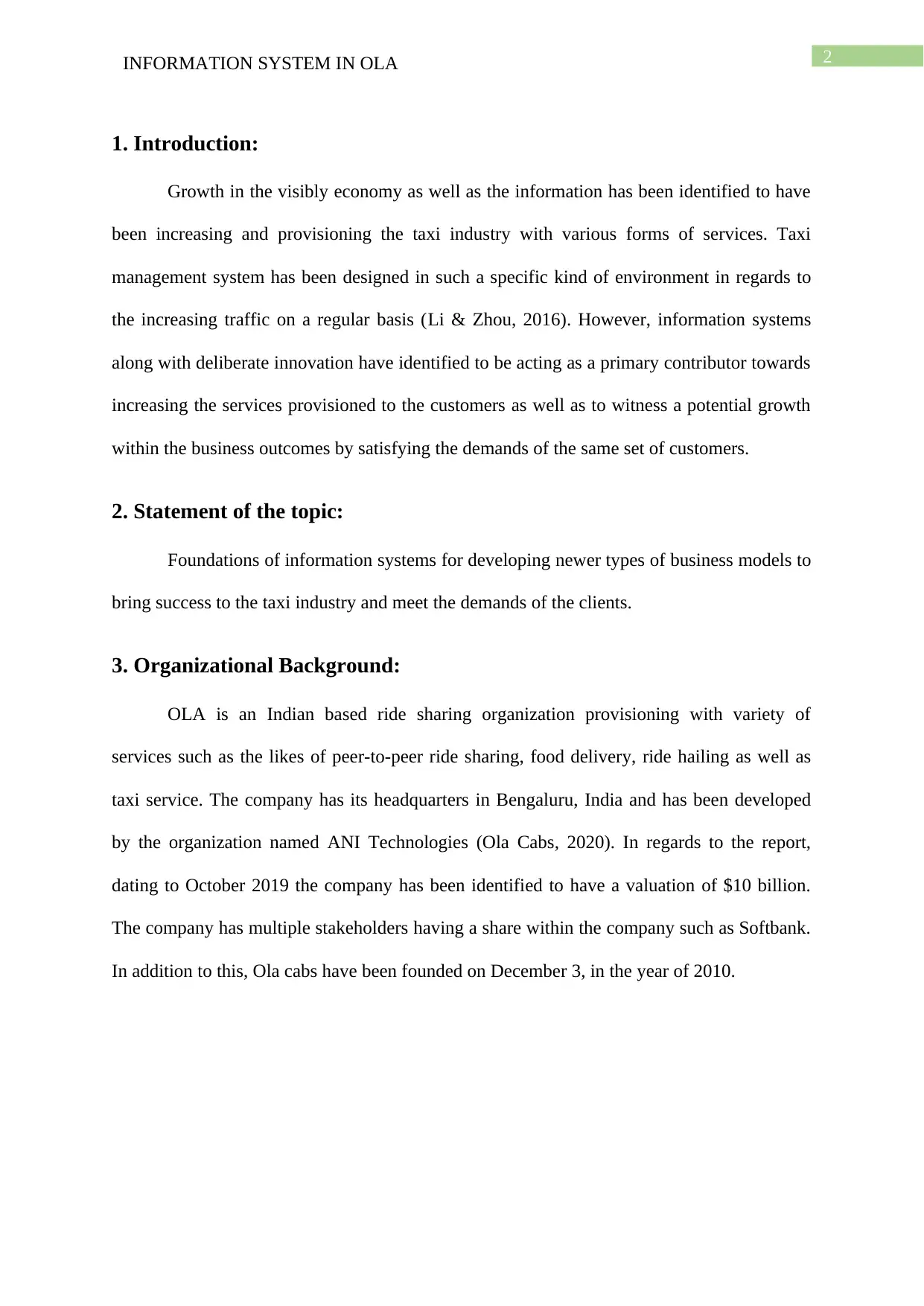
2INFORMATION SYSTEM IN OLA
1. Introduction:
Growth in the visibly economy as well as the information has been identified to have
been increasing and provisioning the taxi industry with various forms of services. Taxi
management system has been designed in such a specific kind of environment in regards to
the increasing traffic on a regular basis (Li & Zhou, 2016). However, information systems
along with deliberate innovation have identified to be acting as a primary contributor towards
increasing the services provisioned to the customers as well as to witness a potential growth
within the business outcomes by satisfying the demands of the same set of customers.
2. Statement of the topic:
Foundations of information systems for developing newer types of business models to
bring success to the taxi industry and meet the demands of the clients.
3. Organizational Background:
OLA is an Indian based ride sharing organization provisioning with variety of
services such as the likes of peer-to-peer ride sharing, food delivery, ride hailing as well as
taxi service. The company has its headquarters in Bengaluru, India and has been developed
by the organization named ANI Technologies (Ola Cabs, 2020). In regards to the report,
dating to October 2019 the company has been identified to have a valuation of $10 billion.
The company has multiple stakeholders having a share within the company such as Softbank.
In addition to this, Ola cabs have been founded on December 3, in the year of 2010.
1. Introduction:
Growth in the visibly economy as well as the information has been identified to have
been increasing and provisioning the taxi industry with various forms of services. Taxi
management system has been designed in such a specific kind of environment in regards to
the increasing traffic on a regular basis (Li & Zhou, 2016). However, information systems
along with deliberate innovation have identified to be acting as a primary contributor towards
increasing the services provisioned to the customers as well as to witness a potential growth
within the business outcomes by satisfying the demands of the same set of customers.
2. Statement of the topic:
Foundations of information systems for developing newer types of business models to
bring success to the taxi industry and meet the demands of the clients.
3. Organizational Background:
OLA is an Indian based ride sharing organization provisioning with variety of
services such as the likes of peer-to-peer ride sharing, food delivery, ride hailing as well as
taxi service. The company has its headquarters in Bengaluru, India and has been developed
by the organization named ANI Technologies (Ola Cabs, 2020). In regards to the report,
dating to October 2019 the company has been identified to have a valuation of $10 billion.
The company has multiple stakeholders having a share within the company such as Softbank.
In addition to this, Ola cabs have been founded on December 3, in the year of 2010.
⊘ This is a preview!⊘
Do you want full access?
Subscribe today to unlock all pages.

Trusted by 1+ million students worldwide
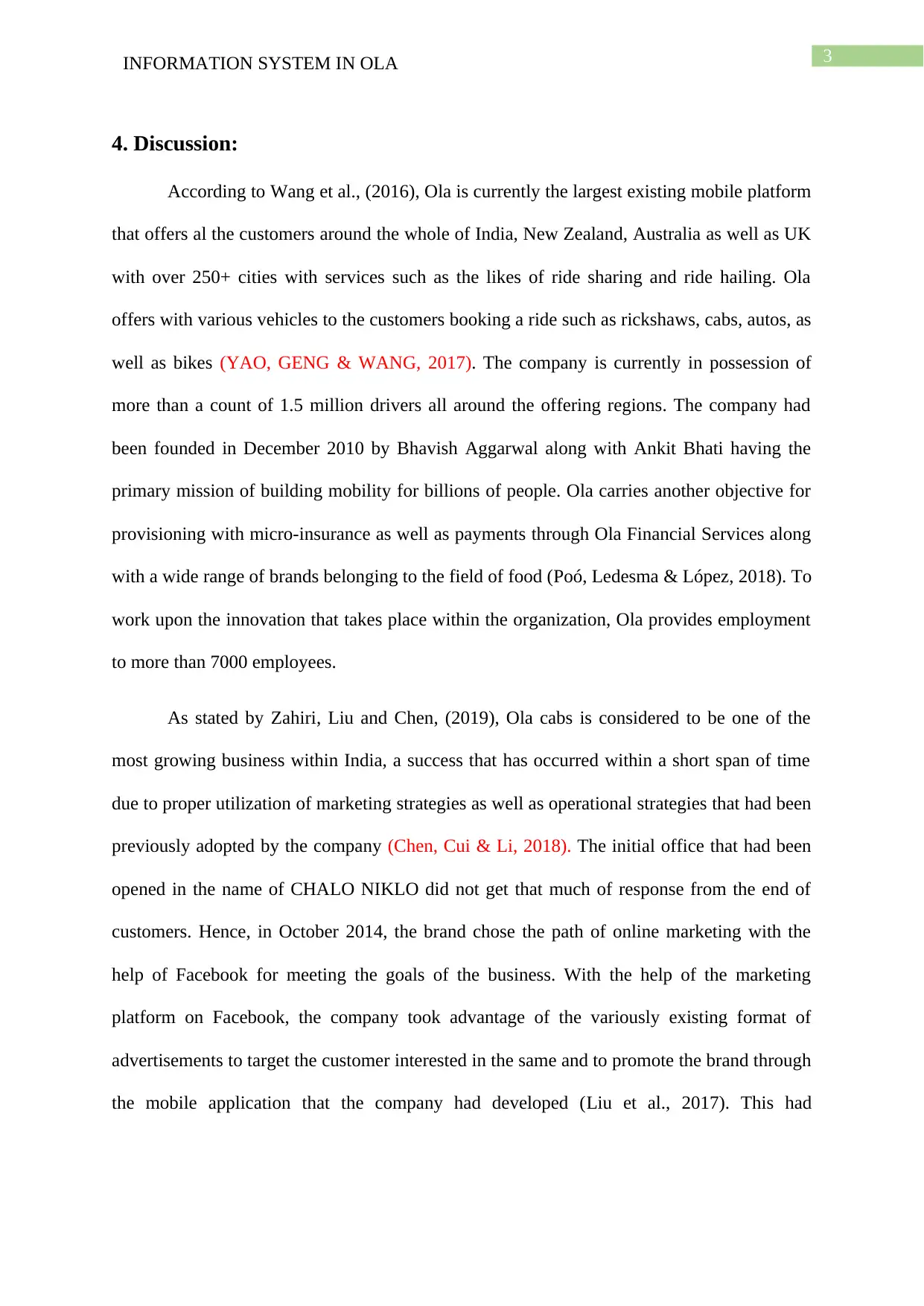
3INFORMATION SYSTEM IN OLA
4. Discussion:
According to Wang et al., (2016), Ola is currently the largest existing mobile platform
that offers al the customers around the whole of India, New Zealand, Australia as well as UK
with over 250+ cities with services such as the likes of ride sharing and ride hailing. Ola
offers with various vehicles to the customers booking a ride such as rickshaws, cabs, autos, as
well as bikes (YAO, GENG & WANG, 2017). The company is currently in possession of
more than a count of 1.5 million drivers all around the offering regions. The company had
been founded in December 2010 by Bhavish Aggarwal along with Ankit Bhati having the
primary mission of building mobility for billions of people. Ola carries another objective for
provisioning with micro-insurance as well as payments through Ola Financial Services along
with a wide range of brands belonging to the field of food (Poó, Ledesma & López, 2018). To
work upon the innovation that takes place within the organization, Ola provides employment
to more than 7000 employees.
As stated by Zahiri, Liu and Chen, (2019), Ola cabs is considered to be one of the
most growing business within India, a success that has occurred within a short span of time
due to proper utilization of marketing strategies as well as operational strategies that had been
previously adopted by the company (Chen, Cui & Li, 2018). The initial office that had been
opened in the name of CHALO NIKLO did not get that much of response from the end of
customers. Hence, in October 2014, the brand chose the path of online marketing with the
help of Facebook for meeting the goals of the business. With the help of the marketing
platform on Facebook, the company took advantage of the variously existing format of
advertisements to target the customer interested in the same and to promote the brand through
the mobile application that the company had developed (Liu et al., 2017). This had
4. Discussion:
According to Wang et al., (2016), Ola is currently the largest existing mobile platform
that offers al the customers around the whole of India, New Zealand, Australia as well as UK
with over 250+ cities with services such as the likes of ride sharing and ride hailing. Ola
offers with various vehicles to the customers booking a ride such as rickshaws, cabs, autos, as
well as bikes (YAO, GENG & WANG, 2017). The company is currently in possession of
more than a count of 1.5 million drivers all around the offering regions. The company had
been founded in December 2010 by Bhavish Aggarwal along with Ankit Bhati having the
primary mission of building mobility for billions of people. Ola carries another objective for
provisioning with micro-insurance as well as payments through Ola Financial Services along
with a wide range of brands belonging to the field of food (Poó, Ledesma & López, 2018). To
work upon the innovation that takes place within the organization, Ola provides employment
to more than 7000 employees.
As stated by Zahiri, Liu and Chen, (2019), Ola cabs is considered to be one of the
most growing business within India, a success that has occurred within a short span of time
due to proper utilization of marketing strategies as well as operational strategies that had been
previously adopted by the company (Chen, Cui & Li, 2018). The initial office that had been
opened in the name of CHALO NIKLO did not get that much of response from the end of
customers. Hence, in October 2014, the brand chose the path of online marketing with the
help of Facebook for meeting the goals of the business. With the help of the marketing
platform on Facebook, the company took advantage of the variously existing format of
advertisements to target the customer interested in the same and to promote the brand through
the mobile application that the company had developed (Liu et al., 2017). This had
Paraphrase This Document
Need a fresh take? Get an instant paraphrase of this document with our AI Paraphraser
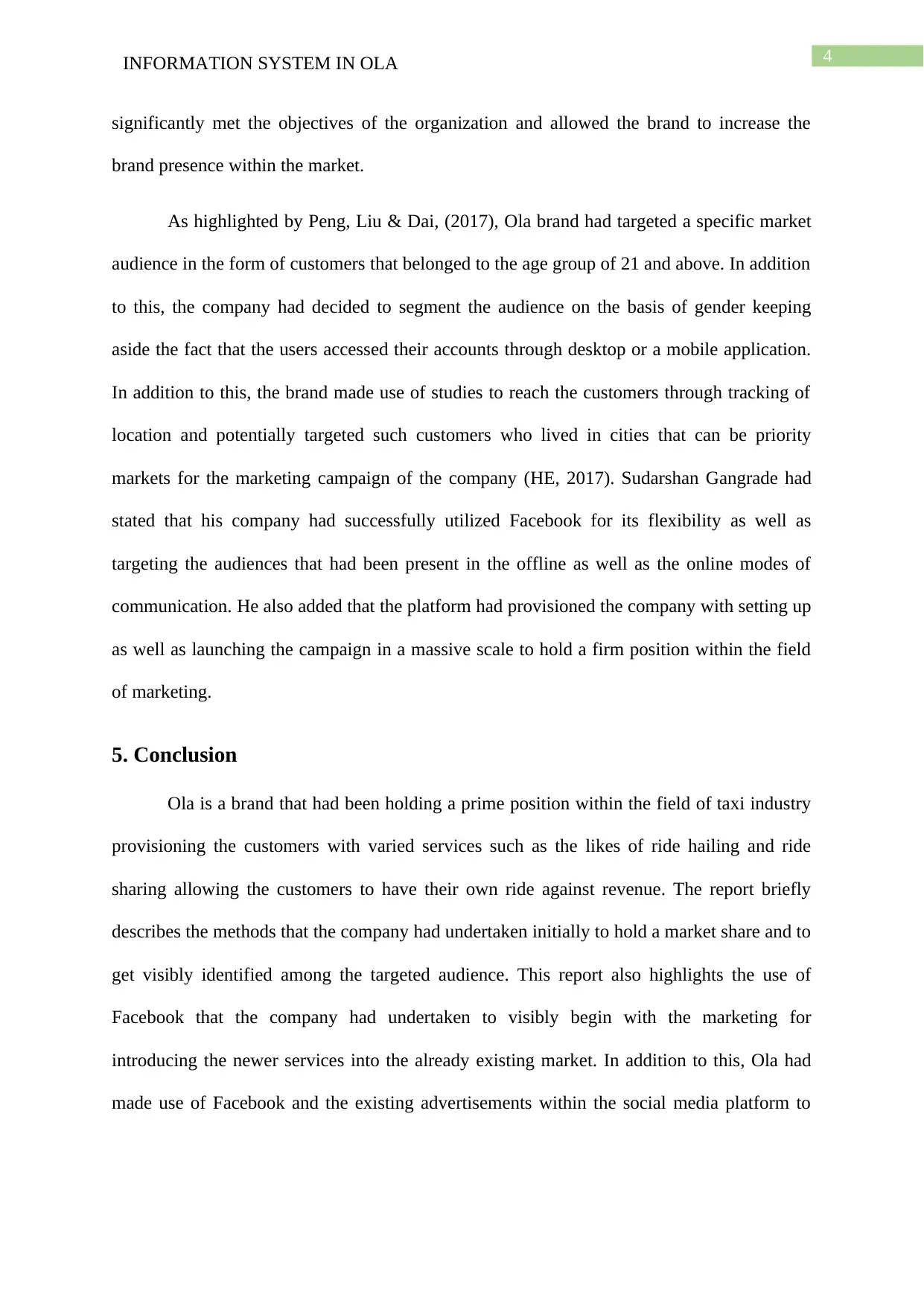
4INFORMATION SYSTEM IN OLA
significantly met the objectives of the organization and allowed the brand to increase the
brand presence within the market.
As highlighted by Peng, Liu & Dai, (2017), Ola brand had targeted a specific market
audience in the form of customers that belonged to the age group of 21 and above. In addition
to this, the company had decided to segment the audience on the basis of gender keeping
aside the fact that the users accessed their accounts through desktop or a mobile application.
In addition to this, the brand made use of studies to reach the customers through tracking of
location and potentially targeted such customers who lived in cities that can be priority
markets for the marketing campaign of the company (HE, 2017). Sudarshan Gangrade had
stated that his company had successfully utilized Facebook for its flexibility as well as
targeting the audiences that had been present in the offline as well as the online modes of
communication. He also added that the platform had provisioned the company with setting up
as well as launching the campaign in a massive scale to hold a firm position within the field
of marketing.
5. Conclusion
Ola is a brand that had been holding a prime position within the field of taxi industry
provisioning the customers with varied services such as the likes of ride hailing and ride
sharing allowing the customers to have their own ride against revenue. The report briefly
describes the methods that the company had undertaken initially to hold a market share and to
get visibly identified among the targeted audience. This report also highlights the use of
Facebook that the company had undertaken to visibly begin with the marketing for
introducing the newer services into the already existing market. In addition to this, Ola had
made use of Facebook and the existing advertisements within the social media platform to
significantly met the objectives of the organization and allowed the brand to increase the
brand presence within the market.
As highlighted by Peng, Liu & Dai, (2017), Ola brand had targeted a specific market
audience in the form of customers that belonged to the age group of 21 and above. In addition
to this, the company had decided to segment the audience on the basis of gender keeping
aside the fact that the users accessed their accounts through desktop or a mobile application.
In addition to this, the brand made use of studies to reach the customers through tracking of
location and potentially targeted such customers who lived in cities that can be priority
markets for the marketing campaign of the company (HE, 2017). Sudarshan Gangrade had
stated that his company had successfully utilized Facebook for its flexibility as well as
targeting the audiences that had been present in the offline as well as the online modes of
communication. He also added that the platform had provisioned the company with setting up
as well as launching the campaign in a massive scale to hold a firm position within the field
of marketing.
5. Conclusion
Ola is a brand that had been holding a prime position within the field of taxi industry
provisioning the customers with varied services such as the likes of ride hailing and ride
sharing allowing the customers to have their own ride against revenue. The report briefly
describes the methods that the company had undertaken initially to hold a market share and to
get visibly identified among the targeted audience. This report also highlights the use of
Facebook that the company had undertaken to visibly begin with the marketing for
introducing the newer services into the already existing market. In addition to this, Ola had
made use of Facebook and the existing advertisements within the social media platform to
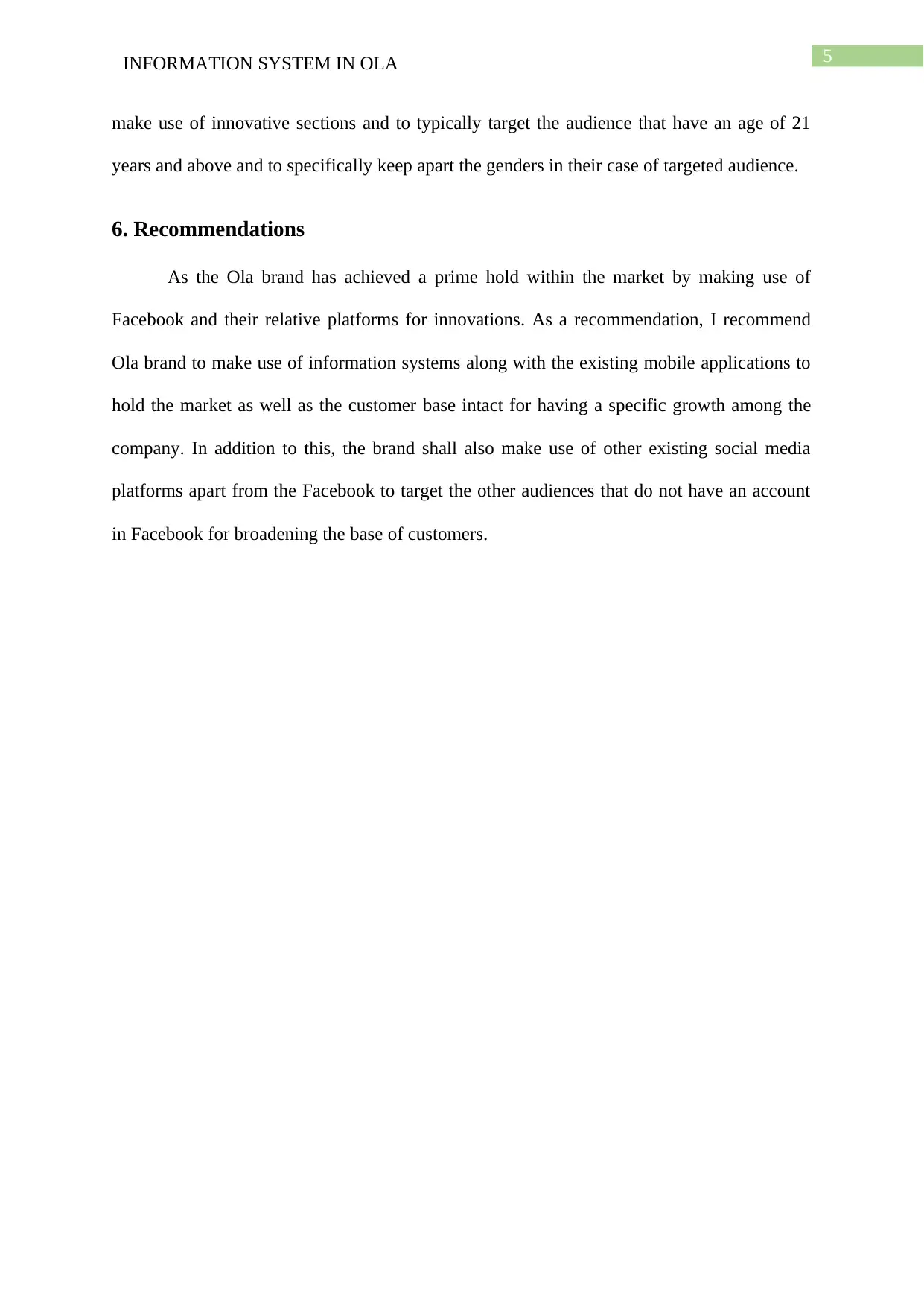
5INFORMATION SYSTEM IN OLA
make use of innovative sections and to typically target the audience that have an age of 21
years and above and to specifically keep apart the genders in their case of targeted audience.
6. Recommendations
As the Ola brand has achieved a prime hold within the market by making use of
Facebook and their relative platforms for innovations. As a recommendation, I recommend
Ola brand to make use of information systems along with the existing mobile applications to
hold the market as well as the customer base intact for having a specific growth among the
company. In addition to this, the brand shall also make use of other existing social media
platforms apart from the Facebook to target the other audiences that do not have an account
in Facebook for broadening the base of customers.
make use of innovative sections and to typically target the audience that have an age of 21
years and above and to specifically keep apart the genders in their case of targeted audience.
6. Recommendations
As the Ola brand has achieved a prime hold within the market by making use of
Facebook and their relative platforms for innovations. As a recommendation, I recommend
Ola brand to make use of information systems along with the existing mobile applications to
hold the market as well as the customer base intact for having a specific growth among the
company. In addition to this, the brand shall also make use of other existing social media
platforms apart from the Facebook to target the other audiences that do not have an account
in Facebook for broadening the base of customers.
⊘ This is a preview!⊘
Do you want full access?
Subscribe today to unlock all pages.

Trusted by 1+ million students worldwide
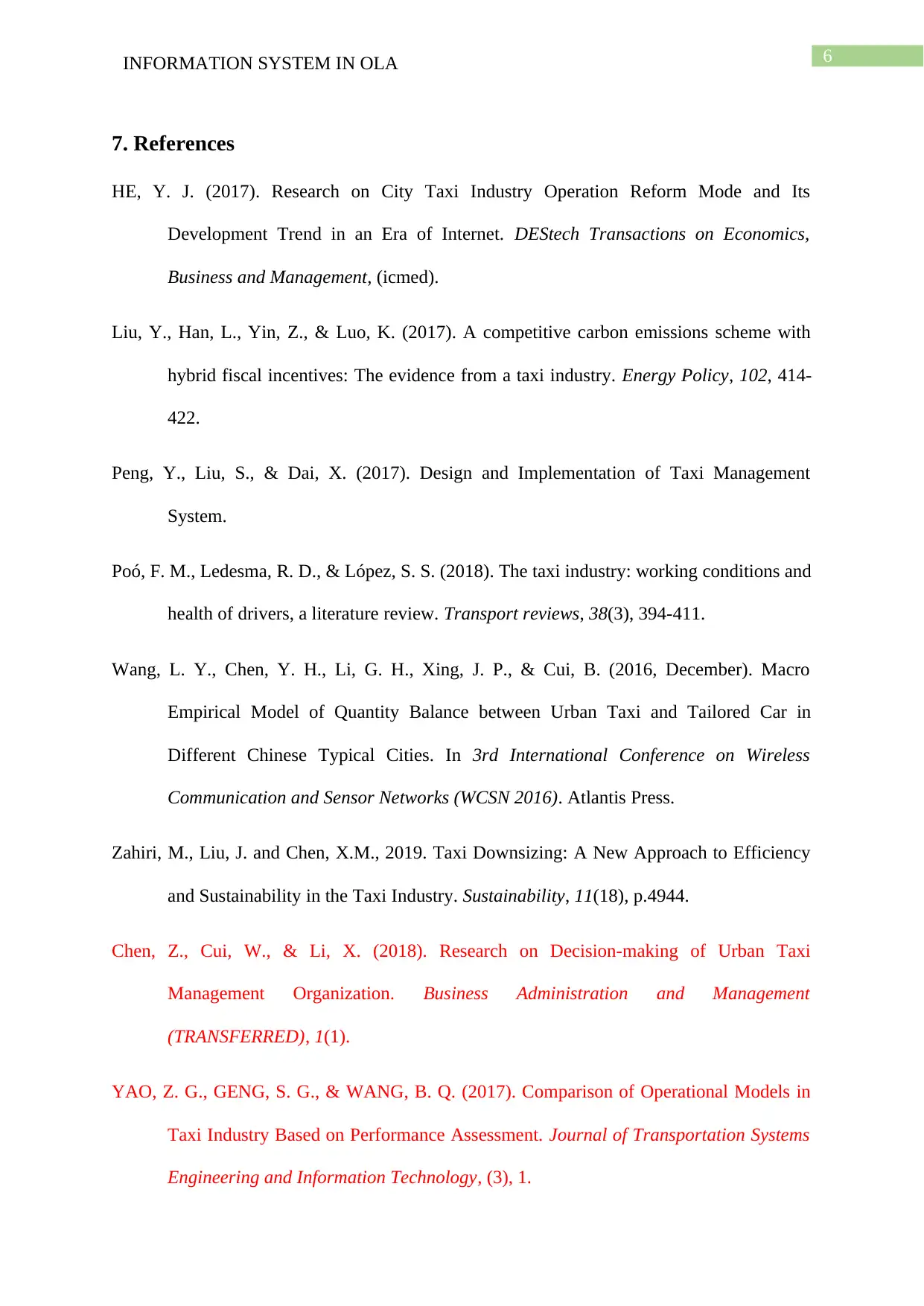
6INFORMATION SYSTEM IN OLA
7. References
HE, Y. J. (2017). Research on City Taxi Industry Operation Reform Mode and Its
Development Trend in an Era of Internet. DEStech Transactions on Economics,
Business and Management, (icmed).
Liu, Y., Han, L., Yin, Z., & Luo, K. (2017). A competitive carbon emissions scheme with
hybrid fiscal incentives: The evidence from a taxi industry. Energy Policy, 102, 414-
422.
Peng, Y., Liu, S., & Dai, X. (2017). Design and Implementation of Taxi Management
System.
Poó, F. M., Ledesma, R. D., & López, S. S. (2018). The taxi industry: working conditions and
health of drivers, a literature review. Transport reviews, 38(3), 394-411.
Wang, L. Y., Chen, Y. H., Li, G. H., Xing, J. P., & Cui, B. (2016, December). Macro
Empirical Model of Quantity Balance between Urban Taxi and Tailored Car in
Different Chinese Typical Cities. In 3rd International Conference on Wireless
Communication and Sensor Networks (WCSN 2016). Atlantis Press.
Zahiri, M., Liu, J. and Chen, X.M., 2019. Taxi Downsizing: A New Approach to Efficiency
and Sustainability in the Taxi Industry. Sustainability, 11(18), p.4944.
Chen, Z., Cui, W., & Li, X. (2018). Research on Decision-making of Urban Taxi
Management Organization. Business Administration and Management
(TRANSFERRED), 1(1).
YAO, Z. G., GENG, S. G., & WANG, B. Q. (2017). Comparison of Operational Models in
Taxi Industry Based on Performance Assessment. Journal of Transportation Systems
Engineering and Information Technology, (3), 1.
7. References
HE, Y. J. (2017). Research on City Taxi Industry Operation Reform Mode and Its
Development Trend in an Era of Internet. DEStech Transactions on Economics,
Business and Management, (icmed).
Liu, Y., Han, L., Yin, Z., & Luo, K. (2017). A competitive carbon emissions scheme with
hybrid fiscal incentives: The evidence from a taxi industry. Energy Policy, 102, 414-
422.
Peng, Y., Liu, S., & Dai, X. (2017). Design and Implementation of Taxi Management
System.
Poó, F. M., Ledesma, R. D., & López, S. S. (2018). The taxi industry: working conditions and
health of drivers, a literature review. Transport reviews, 38(3), 394-411.
Wang, L. Y., Chen, Y. H., Li, G. H., Xing, J. P., & Cui, B. (2016, December). Macro
Empirical Model of Quantity Balance between Urban Taxi and Tailored Car in
Different Chinese Typical Cities. In 3rd International Conference on Wireless
Communication and Sensor Networks (WCSN 2016). Atlantis Press.
Zahiri, M., Liu, J. and Chen, X.M., 2019. Taxi Downsizing: A New Approach to Efficiency
and Sustainability in the Taxi Industry. Sustainability, 11(18), p.4944.
Chen, Z., Cui, W., & Li, X. (2018). Research on Decision-making of Urban Taxi
Management Organization. Business Administration and Management
(TRANSFERRED), 1(1).
YAO, Z. G., GENG, S. G., & WANG, B. Q. (2017). Comparison of Operational Models in
Taxi Industry Based on Performance Assessment. Journal of Transportation Systems
Engineering and Information Technology, (3), 1.
Paraphrase This Document
Need a fresh take? Get an instant paraphrase of this document with our AI Paraphraser
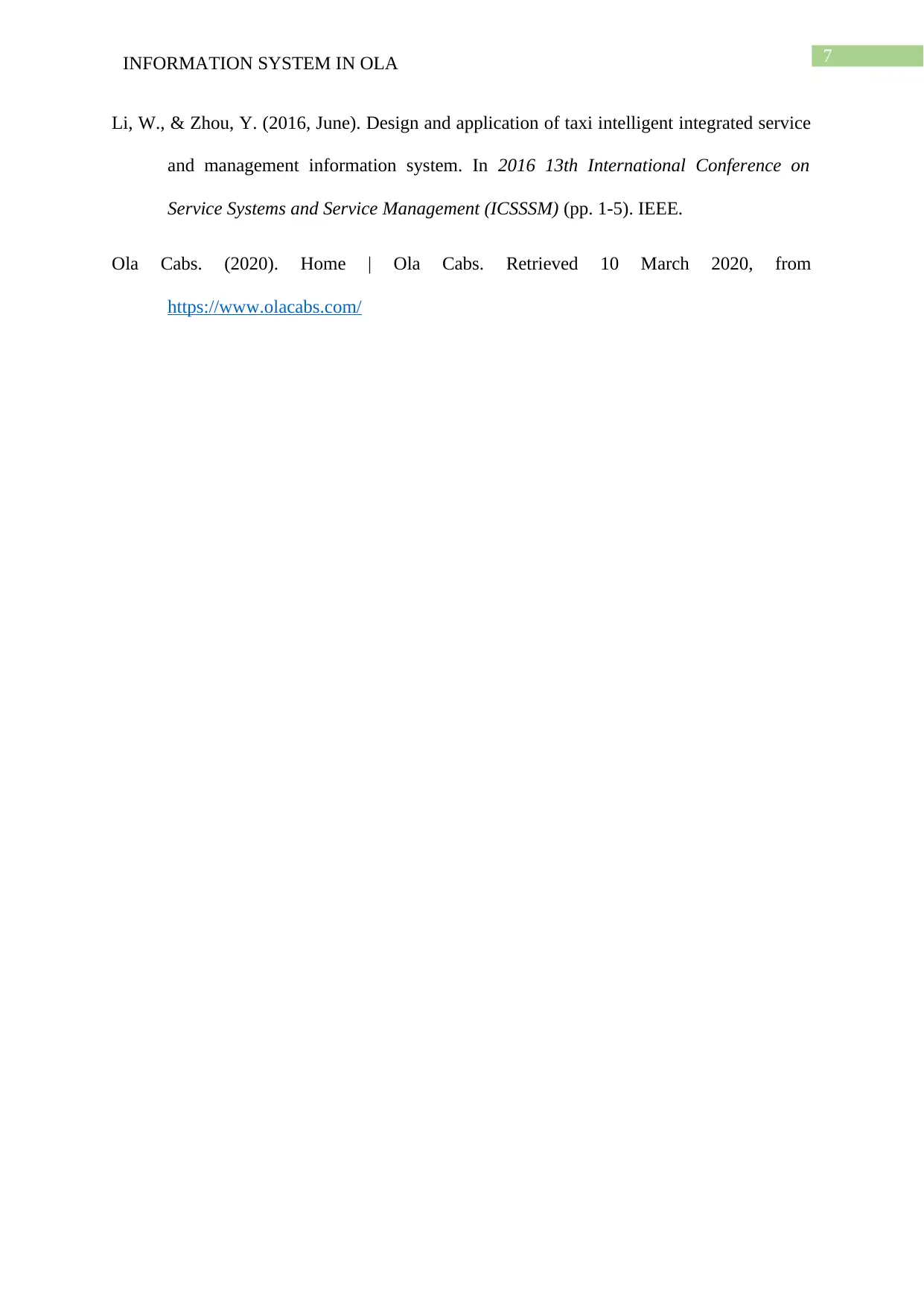
7INFORMATION SYSTEM IN OLA
Li, W., & Zhou, Y. (2016, June). Design and application of taxi intelligent integrated service
and management information system. In 2016 13th International Conference on
Service Systems and Service Management (ICSSSM) (pp. 1-5). IEEE.
Ola Cabs. (2020). Home | Ola Cabs. Retrieved 10 March 2020, from
https://www.olacabs.com/
Li, W., & Zhou, Y. (2016, June). Design and application of taxi intelligent integrated service
and management information system. In 2016 13th International Conference on
Service Systems and Service Management (ICSSSM) (pp. 1-5). IEEE.
Ola Cabs. (2020). Home | Ola Cabs. Retrieved 10 March 2020, from
https://www.olacabs.com/
1 out of 8
Related Documents
Your All-in-One AI-Powered Toolkit for Academic Success.
+13062052269
info@desklib.com
Available 24*7 on WhatsApp / Email
![[object Object]](/_next/static/media/star-bottom.7253800d.svg)
Unlock your academic potential
Copyright © 2020–2025 A2Z Services. All Rights Reserved. Developed and managed by ZUCOL.





